How to use space to increase informal collaboration in the workplace
Subject: Tactics to adopt in your workspace today
It's a fact that employees yearn for social connection in the workplace - something that has a large effect on the level of job satisfaction. Moreover, social interaction goes hand-in-hand with employee collaboration. Achieving collaboration amongst teams is not an easy task. Managing a team can be an art form however the design of the physical environment is the only variable you have complete control over.
(Read more to identify how you can use spatial design to achieve informal collaboration in the workplace.)
Workplace researchers from Knoll and Steelcase have been examining the changing workplace for a number of years. They have noticed a change in trend in the changing nature of work, from a "me" activity to a "we" activity[i]. Increasingly, employees "desire social connection and engagement as part of their collaborative experience"[ii] and "organizations need both operational excellence - and innovation - to succeed" [iii], shifting the focus from themselves, to their experience with others. This is particularly evident in Gen Y workers. The key to promoting social connection and innovation in the workplace is through informal collaboration.
"No social group - whether a family, a work group, or a school group - can survive without constant informal contact among its members"[iv]
While formal meetings and meeting rooms are critical to any organisation, and are here to stay, it is the informal interactions which really allow for creativity and collaboration between staff and within teams.
In some workplaces, informal collaboration will just happen. Often, this is the case in smaller companies, or more creative lines of work, but for those organisations where collaboration does not happen naturally, further steps must be taken to support these interactions.
A study at MIT's Human Dynamics Laboratory[v] looked at a call centre, focussing on what made some teams more successful than others. They found "patterns of communication to be the most important predictor of a team's success" [vi]. In addition to this "the most valuable form of communication is face to face" [vii]. To draw from this, by increasing the opportunities for chance encounters, you are increasing the opportunities for communication and in return for success.
Work space, work tools and work behaviours are all key elements for effective informal collaboration. While, in this instance, we are focussing on work space, it is important that the appropriate technology and work tools support these spaces and work behaviours are implemented to allow these spaces to function.
The workplace is changing, and can be viewed in a similar context to the urban environment. In their book 'Responsive Environments', McGlynn, Smith, Alcock, Murrain and Bentley describe how 'ideals are not enough'[viii], in the design of the physical environment, 'they have to be linked through appropriate design ideas to the fabric of the built environment itself'. To enrich the opportunities of the users, creating a democratic environment, the built environment should provide a number of choices, and settings. This, in turn, allows the user to make their own choices, creating a responsive environment
Path of travel & permeability
To be effective, spaces need to provide easy access and flow organically. If we're looking at an existing open plan office, firstly we must understand how people move through the space and provide a number of primary and secondary circulation paths.
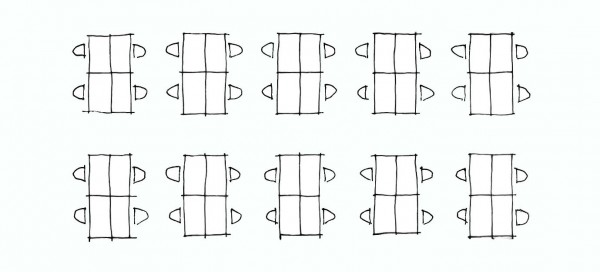
How do people naturally move around the space?
'Only places that are accessible to people can offer them choice.'[ix] The quality and range of choices provide that responsive environment for changing staff needs.
Having a primary, centralised path of travel increases the use by all staff as well as increasing the occurrence of chance encounters. The centralised path must be wider than the secondary circulation paths, particularly where it connects keydestinations, to support more heavy use.
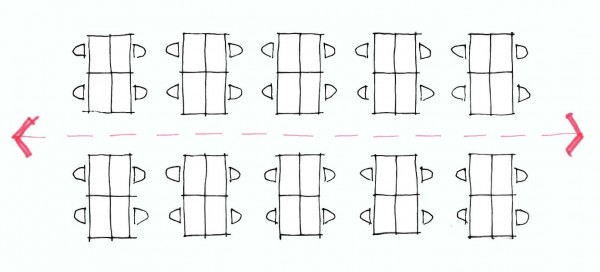
The Piazza
A public, central piazza where people can congregate, helps to bring together different departments within an organisation. This is a multipurpose common area, for use by all staff, to meet, sit, work and talk. It should be located centrally to all workareas and placed along the central path of travel. The range of seating provided should support short term tasks like light focussed work, informal meetings and collaborative work.
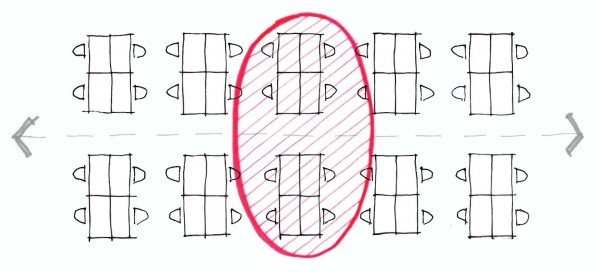
Activation
In order to have a successful piazza, the space needs to be activated. People need a reason to go there. Natural destinations, such as the water cooler, coffee machine or printer, provide opportunities for serendipitous encounters and give people a reason to move away from their desks. By locating these functions adjacent to the piazza, people are drawn to the space, creating a hive of activity. The nature of the activation function, such as a printer, must reflect the nature of the piazza where it is located. The cooperation of these functions strengthens the success of the space.
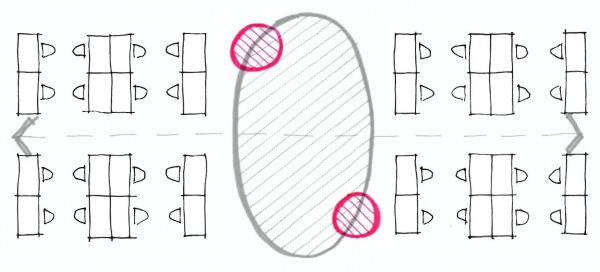
Support spaces
To support the activation zone, semi-enclosed, informal meeting spaces should be located nearby. These create private lingering space on the threshold of the public area, providing a segue to the conversation started at the printer. Informal support spaces should also be threaded along the primary circulation path to support the workspace and offer a space to chat, away from the desk. This can work well in the form of multifunction furniture, such as layout tables between desks which can also be used for one on one mentoring, or standing height storage cabinets along a corridor, which double as a place for a 5-minute chat.
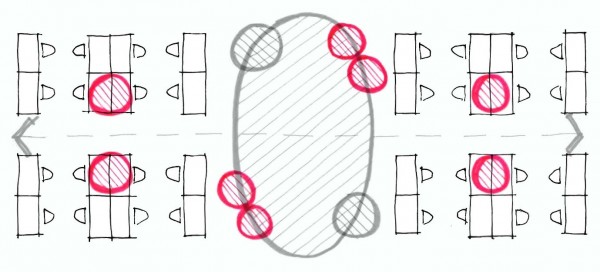
Semi-enclosed workspace
Private space is equally as important as public space in the workplace. The ability to make choices about the type of public or private role is important for workers, however, when barriers go up, communication goes down. A degree of privacy is necessary for focussed work, by when workspaces are fully enclosed the loss of visual and acoustic connection reduces the opportunities for staff to communicate and decreases the permeability of the workplace.
By providing work teams with semi enclosed spaces, their privacy is increased, and the sense of team reinforced. They are given a space that they can own and personalise, while maintaining the permeability and connection to the rest of the workplace.
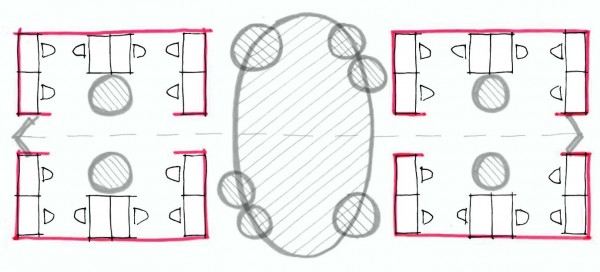
Informal collaboration is not simply introducing new furniture to a workplace. While the arrangement of space encourages chance encounters and facilitates informal interactions, the work tools and work behaviours established within and organisation must also work to enhance collaboration. To see the full benefits that collaboration can have in your workplace, work space, work tools and work behaviours are all equally important.
For more information about Team Base Working, to download a whitepaper or book a live tour click on the this link: www.teambasedworkplace.com.au
[i] Steelcase. "How the workplace can improve collaboration" 360steelcase.com. June, 2010. https://www.steelcase.com/content/uploads/2015/01/threesixty-collaboration-white-paper-v2.6.pdf (accessed August 3, 2017).
[ii] Knoll Workplace Research. "Creating Collaborative Spaces that Work: A Performance-based Approach to Successful Planning" knoll.com. 2013.
https://www.knoll.com/document/1352994554274/CollaborativeWorkplace_wp.pdf (accessed August 3, 2017).
[iii] Knoll Workplace Research. "Creating Collaborative Spaces that Work: A Performance-based Approach to Successful Planning" knoll.com. 2013.
https://www.knoll.com/document/1352994554274/CollaborativeWorkplace_wp.pdf (accessed August 3, 2017).
[iv] Alexander, Christopher, Ishikawa, S., and Silverstein, M. A Pattern Language OUP, New York 1977, p.224.
[v] Pentland, A. "The New Science of Building Great Teams" hbr.org. April, 2012.
https://hbr.org/2012/04/the-new-science-of-building-great-teams (accessed August 3, 2017).
[vi] Pentland, A. "The New Science of Building Great Teams" hbr.org. April, 2012.
https://hbr.org/2012/04/the-new-science-of-building-great-teams (accessed August 3, 2017).
[vii] Pentland, A. "The New Science of Building Great Teams" hbr.org. April, 2012.
https://hbr.org/2012/04/the-new-science-of-building-great-teams (accessed August 3, 2017).
[viii] McGlynn, S., Smith, G., Alcock, A., Murrain, P., Bentley, I. Responsive Environments Architectural Press, Great Britain 1985, p. 9.
[ix] McGlynn, S., Smith, G., Alcock, A., Murrain, P., Bentley, I. Responsive Environments Architectural Press, Great Britain 1985, p. 10.


